The 75 best looking films ever made
Into the top 30......
Takeo Kimura deserves a mention in this one for the absolute ludicrous nature of the set design and production design (sharp suits matching backgrounds and lights changing colours). The colours are just off the chart. The film itself is a little messy as there are alot of characters and the scene jumps tend to be quick. But lordy is it a joy to watch on a big screen. Completely eye popping.
.................................................................................................... ......................................................................................
This film is a technical and visual masterpiece. The camera movements, crane usage, neon lights and hallucinatory nature of it are just spectacular. Noe's ability to make the viewer feel nauseous but also intrigued enough that we don't switch off are almost unparalleled. The feeling of flying through the Tokyo night air and peeping in on these people's troubled lives is a hell of an experience.
.................................................................................................... ......................................................................................
Is there much to say about this film that hasn't already been said? Timeless, pioneering, groundbreaking, masterpiece. The film ushered a new dawn of colour in film. Just imagine the audience's faces in theatres watching this.
.................................................................................................... ......................................................................................
Another technical masterpiece. Freddie Young's visionary cinematography looks as stunning today as ever. Apparently he commissioned Panavision to make a special type of lens to film Omar Shariff's emerging into the desert mirage, it's now known as 'The David Lean lens' in the industry. That type of meticulous attention to detail meant that the film took so long to make (plus the conditions of the desert location in Jordan). Lawrence of Arabia is the epic of all epics.
.................................................................................................... ......................................................................................
The Tree of Life is a polarizing film. Some say it's pretentious, some say life affirming. Surely one thing that everyone can agree on is it's beauty. Lubezki uses his trademark natural light shots as often as he can to give off an other worldly, spiritual tone, and when mixed with underwater shots, volcanoes and other natural phenomena, the film takes on a whole new level of the ethereal. It's not for everybody but it is a beautiful film to look at.
No.30: 'Tokyo Drifter' (1966)
Directed by: Seijun Suzuki
DoP.: Shigeyoshi Mine
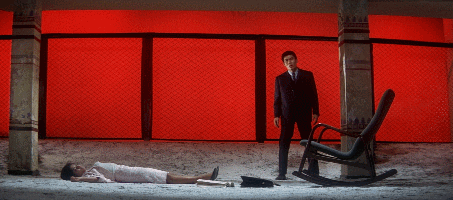
Directed by: Seijun Suzuki
DoP.: Shigeyoshi Mine

Takeo Kimura deserves a mention in this one for the absolute ludicrous nature of the set design and production design (sharp suits matching backgrounds and lights changing colours). The colours are just off the chart. The film itself is a little messy as there are alot of characters and the scene jumps tend to be quick. But lordy is it a joy to watch on a big screen. Completely eye popping.
.................................................................................................... ......................................................................................
No.29: 'Enter the Void' (2009)
Directed by: Gaspar Noe
DoP.: Benoît Debie
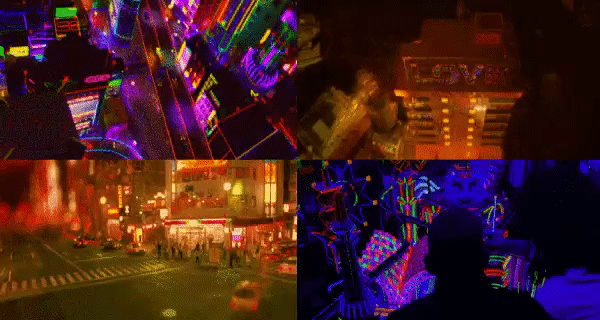
Directed by: Gaspar Noe
DoP.: Benoît Debie

This film is a technical and visual masterpiece. The camera movements, crane usage, neon lights and hallucinatory nature of it are just spectacular. Noe's ability to make the viewer feel nauseous but also intrigued enough that we don't switch off are almost unparalleled. The feeling of flying through the Tokyo night air and peeping in on these people's troubled lives is a hell of an experience.
.................................................................................................... ......................................................................................
No.28: 'The Wizard of Oz' (1939)
Directed by: Victor Fleming
DoP.: Harold Rosson

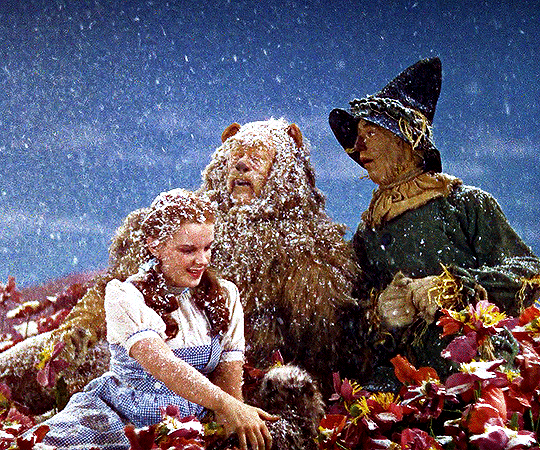
Directed by: Victor Fleming
DoP.: Harold Rosson


Is there much to say about this film that hasn't already been said? Timeless, pioneering, groundbreaking, masterpiece. The film ushered a new dawn of colour in film. Just imagine the audience's faces in theatres watching this.
.................................................................................................... ......................................................................................
No.27: 'Lawrence of Arabia' (1962)
Directed by: David Lean
DoP.: Freddie Young
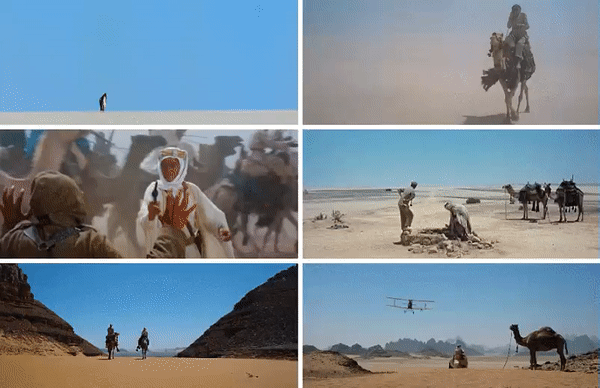
Directed by: David Lean
DoP.: Freddie Young

Another technical masterpiece. Freddie Young's visionary cinematography looks as stunning today as ever. Apparently he commissioned Panavision to make a special type of lens to film Omar Shariff's emerging into the desert mirage, it's now known as 'The David Lean lens' in the industry. That type of meticulous attention to detail meant that the film took so long to make (plus the conditions of the desert location in Jordan). Lawrence of Arabia is the epic of all epics.
.................................................................................................... ......................................................................................
No.26: 'The Tree of Life' (2011)
Directed by Terrence Malick
DoP.: Emmanuel Lubezki
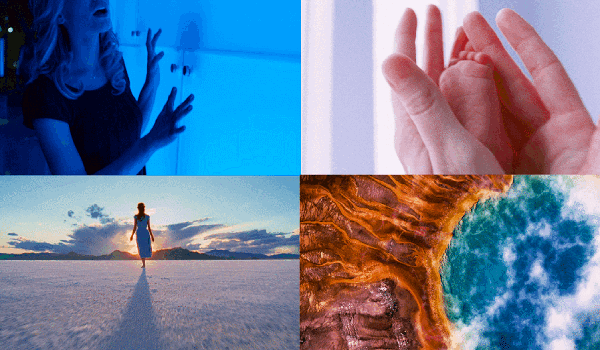
Directed by Terrence Malick
DoP.: Emmanuel Lubezki

The Tree of Life is a polarizing film. Some say it's pretentious, some say life affirming. Surely one thing that everyone can agree on is it's beauty. Lubezki uses his trademark natural light shots as often as he can to give off an other worldly, spiritual tone, and when mixed with underwater shots, volcanoes and other natural phenomena, the film takes on a whole new level of the ethereal. It's not for everybody but it is a beautiful film to look at.
X
Favorite Movies
X
User Lists
Lawks, five at once eh 
Tokyo Drifter is certainly stylish, a shame the whole doesn't quite live up to the way it looks imo but a decent choice for a list such as this. I've tried a couple of Noe fillums and just can't watch them so can't comment on Enter The Void. Love The Wizard Of Oz though, a treat to look at and a delight to watch.
No problem with Lawrence Of Arabia making the list, I remember it being very good but haven't yet felt an urge to devote the time to revisit it, though I do hope I will some day. The Tree Of Life has some nice visuals and is ok once Malick has satisfied himself in those first few minutes.

Tokyo Drifter is certainly stylish, a shame the whole doesn't quite live up to the way it looks imo but a decent choice for a list such as this. I've tried a couple of Noe fillums and just can't watch them so can't comment on Enter The Void. Love The Wizard Of Oz though, a treat to look at and a delight to watch.
No problem with Lawrence Of Arabia making the list, I remember it being very good but haven't yet felt an urge to devote the time to revisit it, though I do hope I will some day. The Tree Of Life has some nice visuals and is ok once Malick has satisfied himself in those first few minutes.
I haven't seen Tokyo Drifter, but I agree on the other four. Also, I'm a huge fan of The Tree of Life.
X
Favorite Movies
X
User Lists
Malick just isn’t the director for me, sadly. I need to watch his post Tree of Life stuff, and Badlands still, but I haven’t been too crazy about his work.
X
Favorite Movies
X
User Lists
No. 25: 'The Lady from Shanghai' (1947)
Directed by Orson Welles
DoP.: Charles Lawton Jr.

Directed by Orson Welles
DoP.: Charles Lawton Jr.

Welles' genius shines through in this film with placements of camera and reflections in mirrors dizzying the viewer into a claustrophobic and hallucinatory experience. This is one of Welles' masterpieces, helped by cinematographer Charles Lawton Jnr's genius ideas. Sometimes this film doesn't get the praise it deserves and people focus on W3lles' other films but it really should be up there in the conversation as it's not just a great looking noir but also a very well structured film with Rita Hayworth and Welles himself giving A Grade performances.
.................................................................................................... ..........................................................
No. 24: 'An Actor's revenge' (1963)
Directed by: Kon Ichikawa
DoP.: Setsuo Kobayashi
Directed by: Kon Ichikawa
DoP.: Setsuo Kobayashi

This is a film that has had a few iterations in Japanese cinema as the story is quite a famous one in Japanese culture. I can't claim to have seen all versions but the 1963 version by Ichikawa is so visually impressive that it has to make the list. The story itself is a little contrived but the visuals make up for it - with set design and lights that turn on and off making a really noticeable aesthetic.

.................................................................................................... ..............................................................
No.23: 'Werckmeister Harmonies' (2000)
Directed by: Béla Tarr & Ágnes Hranitzky
DoP.: Patrick de Ranter, Miklós Gurbán, Erwin Lanzensberger, Gábor Medvigy, Emil Novák, Rob Tregenza

Directed by: Béla Tarr & Ágnes Hranitzky
DoP.: Patrick de Ranter, Miklós Gurbán, Erwin Lanzensberger, Gábor Medvigy, Emil Novák, Rob Tregenza

Tarr's masterpiece is essentially 39 slow paced tracking shots stitched together and has a life size whale. Some of the images are just mesmerizing in their beauty and others are sparse contrast of black figures on white background. The cinematography was undertaken by a team rather than a head of photography, and the result is just a beautiful, poignant rumination on modern Hungary.
.................................................................................................... .............................................................
No. 22: 'Vertigo' (1958)
Directed by Alfred Hitchcock
DoP.: Robert Burks

Directed by Alfred Hitchcock
DoP.: Robert Burks

Hitchcock uses green so well in this film, to elevate that colour into the viewer's consciousness as the colour of mystery and the eternal. It's such a beautiful film to watch unfold even as the horror elements entwine with the love story.
.................................................................................................... ..............................................................
No. 21: 'Mirror' (1975)
Directed by Andrei Tarkovsky
DoP.: Georgi Rerberg

Directed by Andrei Tarkovsky
DoP.: Georgi Rerberg

Tarkovsky and long time collaborator Georgi Rerberg produced one of the most stunning films of the 1970s in 'Mirror'. As with alot of Tarkovsky's films there is a very loose plot and the film resembles visual poetry more than a traditional narrative.

But it is a sublime work of art that drifts from monochrome back to colour and has striking sequences of slow motion glass crashing, floating women and birds landing on people's heads. Part of the film is based on the life of Tarkovsky's own father as he has a painful divorce from his mother (who actually appears in the film).
The Mirror really shows off Tarkovsky's perfectionist trait - the final version of the film is apparently the 33rd version Tarkovsky filmed. He binned the first 32. And the gust of wind we see in the early field scene is created by a helicopter that was positioned out of shot.
X
Favorite Movies
X
User Lists
The Lady From Shanghai certainly has some inventive shots and is a decent enough watch, shame about Welles' accent in it though. Not seen either An Actor's Revenge or Werckmeister Harmonies so can't comment on them specifically, both 60s Japanese colour and crisp b&w in general are both certainly looks I love though.
I'm not the hugest fan of the tale in Vertigo but there's no denying it's quite a stylish looking fillum. Mirror is my favourite Tarkovsky so naturally I'm delighted to see it make this list.
I'm not the hugest fan of the tale in Vertigo but there's no denying it's quite a stylish looking fillum. Mirror is my favourite Tarkovsky so naturally I'm delighted to see it make this list.
Into the top 20:
Wenders direction and Muller's photography are such a winning combo in this film. They even manage to make a somewhat mundane telephone booth conversation beautiful due mainly to reflections, colours and lighting. It's such a journey this film. Starts out being a mystery and ends up beat a devastating emotional gut punch. But en route there are some fabulous shot compositions featuring neon lights, bright greens and reds - inspired by the artwork of Edward Hopper. Towards the end we see this shot, which is one of my all time favourite shots in the whole of cinema, if not my favourite:
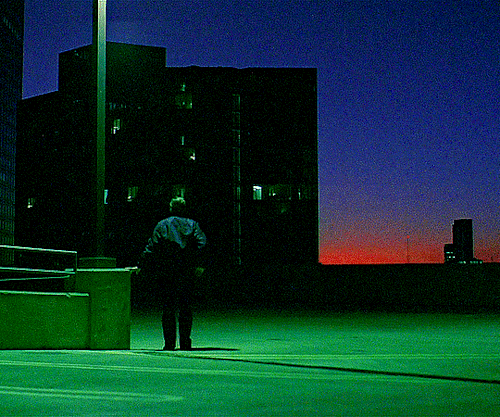
A sublime film
.................................................................................................... ...................................................................
Another of those 1960s Japanese folk horror films that use shadows and lighting so well. Shindo's clever use of contrast makes the ghostly character float into frame and gives it a real creepy vibe. A classic.
.................................................................................................... ...................................................................
Last year at Marienbad is a polarising film. It's a mindbender with puzzling characters, a very loose narrative and ambiguity everywhere. Some like it, some don't. What it definitely is though, is stunning to look at. The location helps (Amalienburg Hunting lodge and Schleissheim palace near Munich, Germany). The interiors and exteriors of the beautiful buildings are hard to forget once seen and Sacha Vierny's photography captures them brilliantly.
.................................................................................................... ...................................................................
Goodness knows how long this film took to organise, plan, choreograph and execute. It's a one taker with a cast of thousands. Easily one of the greatest achievements in modern cinema. And the images are just spellbinding.

Dancers, lords, artists, you name it they keep on coming, into the image then out of it, as we travel through the Russian State Hermitage Museum and all it's glory and visit characters from Russian history. It has to be seen to be believed. Mesmerising film.

.................................................................................................... ...................................................................
Apparently, there are no built sets in this film - just costumes and props. There is no CGI. Just cameras and actors. Pretty phenomenal considering how the movie looks. It was shot in 28 different countries and took 4 years to film. It's loosely based on a Bulgarian film from 1981 called 'Yo ho ho' but it is very much it's own film and is stunning to look at. Almost every scene that isn't based in the hospital is just huge, epic and sweeping. The narrative itself falls a bit short and gets a little messy towards the end, but the film is so gorgeous to look at that it almost doesn't matter.
.................................................................................................... ...................................................................
No. 20: 'Paris, Texas' (1984)
Directed by Wim Wenders
DoP.: Robbie Muller

Directed by Wim Wenders
DoP.: Robbie Muller

Wenders direction and Muller's photography are such a winning combo in this film. They even manage to make a somewhat mundane telephone booth conversation beautiful due mainly to reflections, colours and lighting. It's such a journey this film. Starts out being a mystery and ends up beat a devastating emotional gut punch. But en route there are some fabulous shot compositions featuring neon lights, bright greens and reds - inspired by the artwork of Edward Hopper. Towards the end we see this shot, which is one of my all time favourite shots in the whole of cinema, if not my favourite:

A sublime film
.................................................................................................... ...................................................................
No. 19: 'Onibaba' (1964)
Directed by Kaneto Shindō
DoP.: Kiyomi Kuroda

Directed by Kaneto Shindō
DoP.: Kiyomi Kuroda

Another of those 1960s Japanese folk horror films that use shadows and lighting so well. Shindo's clever use of contrast makes the ghostly character float into frame and gives it a real creepy vibe. A classic.
.................................................................................................... ...................................................................
No. 18: 'Last Year at Marienbad' (1961)
Directed by Alain Resnais
DoP.: Sacha Vierny

Directed by Alain Resnais
DoP.: Sacha Vierny

Last year at Marienbad is a polarising film. It's a mindbender with puzzling characters, a very loose narrative and ambiguity everywhere. Some like it, some don't. What it definitely is though, is stunning to look at. The location helps (Amalienburg Hunting lodge and Schleissheim palace near Munich, Germany). The interiors and exteriors of the beautiful buildings are hard to forget once seen and Sacha Vierny's photography captures them brilliantly.
.................................................................................................... ...................................................................
No. 17: 'Russian Ark' (2002)
Directed by Aleksandr Sokurov
DoP.: Tilman Büttner
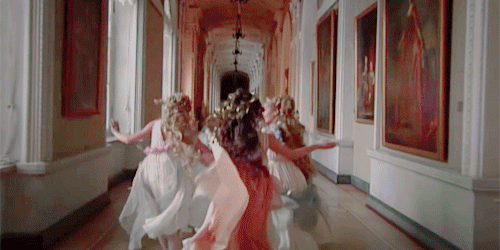
Directed by Aleksandr Sokurov
DoP.: Tilman Büttner

Goodness knows how long this film took to organise, plan, choreograph and execute. It's a one taker with a cast of thousands. Easily one of the greatest achievements in modern cinema. And the images are just spellbinding.

Dancers, lords, artists, you name it they keep on coming, into the image then out of it, as we travel through the Russian State Hermitage Museum and all it's glory and visit characters from Russian history. It has to be seen to be believed. Mesmerising film.

.................................................................................................... ...................................................................
No. 16: 'The Fall' (2006)
Directed by Tarsem Singh
DoP.: Colin Watkinson

Directed by Tarsem Singh
DoP.: Colin Watkinson

Apparently, there are no built sets in this film - just costumes and props. There is no CGI. Just cameras and actors. Pretty phenomenal considering how the movie looks. It was shot in 28 different countries and took 4 years to film. It's loosely based on a Bulgarian film from 1981 called 'Yo ho ho' but it is very much it's own film and is stunning to look at. Almost every scene that isn't based in the hospital is just huge, epic and sweeping. The narrative itself falls a bit short and gets a little messy towards the end, but the film is so gorgeous to look at that it almost doesn't matter.
.................................................................................................... ...................................................................
X
Favorite Movies
X
User Lists
I've seen all of those five except for Onibaba. Either Russian Ark or Last Year At Marienbad have my favorite cinematography of that bunch. I don't remember loving the photography in Paris, Texas, but I am a big fan of the film and another viewing may get me to like that aspect more.
X
Favorite Movies
X
User Lists
No. 15 ‘Ran’ (1985)
Directed by Akira Kurosawa
DoP.: Asakazu Nakai, Takao Saitô, Shôji Ueda

Directed by Akira Kurosawa
DoP.: Asakazu Nakai, Takao Saitô, Shôji Ueda

Possibly Kurosawa’s most epic, visually stunning film. A retelling of Shakespeare’s King Lear, it is a war film at heart but also has moments of real beauty. The battle scenes are huge. Characters are colourful. Even the way Kurosawa filmed the early scenes in fields and hills feels
.................................................................................................... .........................................................................................
No. 14 ‘Barry Lyndon’ (1975)
Directed by Stanley Kubrick
DoP.: John Alcott

Directed by Stanley Kubrick
DoP.: John Alcott

No gifs can do justice to how incredible this film looks so here are some still images instead. Time and again you hear people say things like ‘every frame of that film could be a painting’ – and it’s easy to see why just looking at those 4 images. It’s a masterwork.
X
Favorite Movies
X
User Lists
Paris, Texas is such an effective film, and yeah nicely uses colour in places. Onibaba is simply a joy to watch. Not seen the other three from that set. Ran's certainly quite a colourful film and well made but sadly I don't hold it in quite the same esteem many seem to. Barry Lyndon on the other hand is indeed a beautifully composed piece.
I need to watch Ran someday as it's probably my biggest blindspot so far. I've seen Barry Lyndon though and it looks great.
X
Favorite Movies
X
User Lists
No 13. ‘The Colour of Pomegranates' (1969)
Directed by Sergei Parajanov
DoP.: Suren Shakhbazyan

Directed by Sergei Parajanov
DoP.: Suren Shakhbazyan

Much like a few other films in this list, the narrative is thin and you just let the images flow, some of them are just beautifully framed. It's supposed to be an allegorical biopic of Armenian poet Sayat Nova. But who knows whether the images connect to any real tales of his life or not. It's worth cranking up the colours on your monitor to watch this one as they jump out.
.................................................................................................... ...................................................................
No 12. ‘The Third Man' (1949)
Directed by Carol Reed
DoP.: Robert Krasker
Directed by Carol Reed
DoP.: Robert Krasker

Carol Reed's British noir film The Third Man is one of the greatest looking noirs of all time and uses so many dutch angles, lighting and shadows. Possibly the greatest use is during the tunnel sequence which is as taught as it is beautifully shot. Orson Welles does a fine job as the character of Harry Lime. But it's Krasker's photography which really helps ramp up the tension. A Great example of how camerawork can add so much.
.................................................................................................... ...................................................................
No 11. ‘The Night of the Hunter' (1955)
Directed by
DoP.: Stanley Cortez
Directed by
DoP.: Stanley Cortez

Yet another black and white crime film. This one, Charles Laughton's only film has Stanley Cortez as the cinematographer, and he delivers a film so dense with amazing shot composition that you could probably use about 100 stills from the film to show how great it looks. Shot after shot of brilliantly composed images that make the viewers eyes dance round the screen.

The great Robert Mitchum is cast perfectly as the heinous villain with his tale of love and hate. This film could easily have been in the top 10 and may be should have been. It's as rewatchable as it is gorgeous.
X
Favorite Movies
X
User Lists
Never seen The Colour of Pomegranates, have seen The Third Man but can't comment on it as that was countless blue moons ago and I've no intention of ever subjecting myself to that awfully annoying zither music again. The Night Of The Hunter is quite beautiful to look at though and fully deserves to be on a list such as this.
Thought for sure Ran would be top 10. Just an absolutely stunning work. My favorite Kurosawa flick by quite a long shot.
__________________
“It takes considerable knowledge just to realize the extent of your own ignorance.” ― Thomas Sowell
X
Favorite Movies
X
User Lists
No 10. ‘I am Cuba' (1964)
Directed by Mikhail Kalatozov
DoP.: Sergey Urusevskiy

Directed by Mikhail Kalatozov
DoP.: Sergey Urusevskiy

Sergei Urusevskiy was a long time collaborator with Kalatazov, and his other films 'Letter Never Sent' and 'The Cranes are flying are equally gorgeous, but it's the camera placings and camera movement that make I am Cuba stand out.
Urusevskiy was a master at using huge cranes to get the effect he wanted and using angles to add tension. The funeral scene in I am Cuba is so epic that I'd not argue with anyone that claimed it is the single greatest shot in cinema:
'I am Cuba' is a masterpiece of Russian cinema and is one of the most ambitiously shot films ever made.
.................................................................................................... ...................................................................
No 9. ‘Days of Heaven' (1978)
Directed by Terence Mallick
DoP.: Néstor Almendros

Directed by Terence Mallick
DoP.: Néstor Almendros

Its well known that alot of Days of Heaven was shot during the golden hours of dusk and dawn to get that natural skylight look. But you still have to be able to frame a scene and make it's composition feel right. You can't just point a camera at the sky. Almendros in this film, seems to be in the zone, he makes shot after shot just dance off the screen with blues, purples and oranges complimenting some amazing set design and costume design.
Mallick has done a few films that could have been in the top 10 for their sheer beauty, but Days of Heaven for me feels the most naturalistic.
.................................................................................................... ...................................................................
No 8. ‘Citizen Kane' (1941)
Directed by Orson Welles
DoP.: Gregg Toland

Directed by Orson Welles
DoP.: Gregg Toland

Early on in this film, the viewer senses they're in for something a little special - that snowball shot that retreats back into the house is jaw dropping. The end of that shot is completely different setting as the beginning and it all happens in around 20 seconds.
This video probably showcases some of the more outstanding shots of the film:
Welles' masterpiece also has and continues to have, huge influence in cinema, the lineage of which, we can see in countless films including:
Apocalypse Now (Coppola)
The Man Who Wasn't There (Coen Brothers)
Blade Runner 2049 (Villeneuve)

A true masterpiece, both visually and narratively.
.................................................................................................... ...................................................................
No 7. ‘Black Narcissus' (1947)
Directed by Michael Powell and Emeric Pressburger
DoP.: Jack Cardiff
Directed by Michael Powell and Emeric Pressburger
DoP.: Jack Cardiff
Jack Cardiff's collaborations with Powell and Pressburger are legendary in British cinema. From his matt painting backgrounds to the use of bright colour, there were about 3 or 4 P&P films that could have ended up in this list. The Red Shoes is notably one of their finest. But Black Narcissus is just that bit more stunning as it has a few truly breathtaking shots.

The way that bell ringing shot is put together is astounding. It made me gasp the first time I saw it. All this in 1947 too! Beautiful film.
.................................................................................................... ...................................................................
No 6. ‘In the Mood for Love' (2000)
Directed by Wong Kar Wai
DoP.: Christopher Doyle , Pun-Leung Kwan , Ping Bin Lee
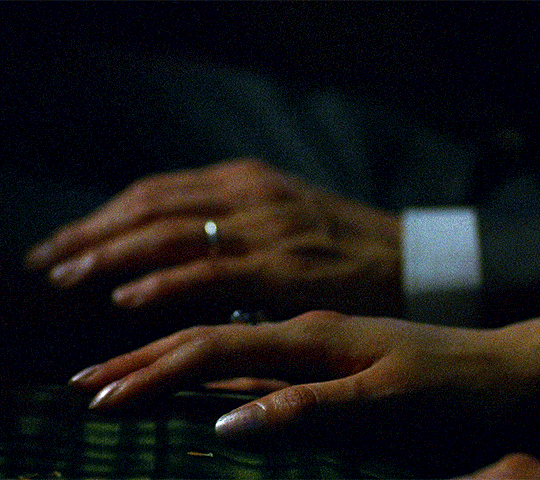

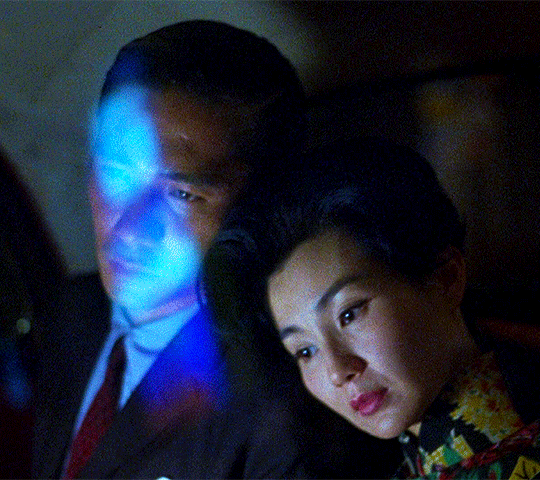

Directed by Wong Kar Wai
DoP.: Christopher Doyle , Pun-Leung Kwan , Ping Bin Lee




The first time I saw this film, I was so engrossed in the visuals that I couldn't concentrate and found that I needed to rewatch it to try and concentrate more on the story. Tony Cheung and Maggie Cheung are so perfectly cast as the lovers not meant to be, and Doyle's typically dreamy cinematography just adds to the atmosphere. Apparently, Maggie Cheung's wardrobe consisted of 46 different dresses used in the unedited cut.
It is just a sublime piece of work which benefits from smoke, rain, drinks, stairwells and dark alleyways, all of which compliment the colourful costumes and facial close ups. Wong Kar Wai's direction is masterful - he is able to stitch in the loneliness and melancholy like ambience into a piece of transcendental, timeless cinema.
A podcast I listened to described the performances as "Two throbbing halves of a broken heart", which I thought was a suitable way to describe this beautiful, devastating masterpiece.
X
Favorite Movies
X


